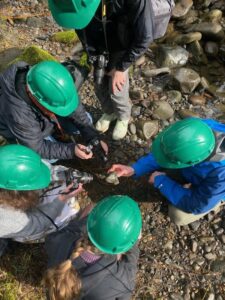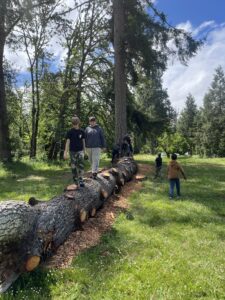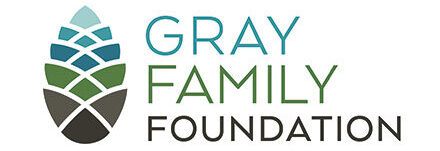One of Emma Garner’s favorite memories as Education Program Manager at Middle Fork Willamette Watershed Council (MFWWC) was when a group of middle schoolers were getting off the bus for a field trip in the forest. There were 100 kids and none of them had been in the woods before.
“It was a sunny day, after a frost,” Garner recalls. “The wind blew through the forest, and all the frosted leaves started to fall.” The kids all giggled, chased the leaves, and shared how cool it was that the wind made everything change.
“Every instructor just paused and allowed these kids to have this moment, and it was really beautiful,” says Garner.
These unplanned moments are just as essential to outdoor education at MFWWC, as the structured lessons and exercises. For Garner, learning on-site out in nature, spontaneity and all, gives way to something that can transcend the lesson plan. “The activities encourage students to wonder, feel, and reflect, which helps build that sense of connection with place.”
 Over the last three years, over 4,500 Lane County middle school students have engaged in hands-on, immersive field trips to a variety of sites through the development and implementation of a Regional Education Program. Born from the partnerships of the Upper Willamette Stewardship Network (UWSN), formed in 2018 to leverage resources and coordinate solutions to the issues facing the Upper Willamette, the program is designed to support teachers and expand regional access to enriching and nimble outdoor education programs.
Over the last three years, over 4,500 Lane County middle school students have engaged in hands-on, immersive field trips to a variety of sites through the development and implementation of a Regional Education Program. Born from the partnerships of the Upper Willamette Stewardship Network (UWSN), formed in 2018 to leverage resources and coordinate solutions to the issues facing the Upper Willamette, the program is designed to support teachers and expand regional access to enriching and nimble outdoor education programs.
The Regional Education Program, supported in part by a Gray Family Foundation Environmental Education grant, began as a pilot program in 2021. Members of the UWSN, which consists of four watershed councils including: MFWWC, Coast Fork, Long Tom, and McKenzie, along with the McKenzie River Trust, Friends of Buford Park and Mt. Pisgah, and the Upper Willamette Soil and Water Conservation District, assessed existing education systems and developed the infrastructure to become a hub of coordination and communication for the Upper Willamette region’s outdoor educational efforts.
That hub is housed at MFWWC, where Garner is part of a team of education professionals. A bulk of the team’s focus goes toward building relationships with teachers and partners connected to natural resources, conservation, and restoration to deepen the pool of resources and institutional knowledge available to develop education programs.
“One of the strengths of a Regional Education approach is that we have committed staff for education, and having us housed out of one location with regional connection has allowed us to build really strong partnerships,” says Garner.
Partners grant students access, and ongoing access over time, to conservation and restoration sites, where they can observe the before and after of restoration work. Students are often invited to take active, hands-on roles in restoration projects through conducting water quality surveys in streams or removing invasive weeds.
“That sort of tangible part of all of these activities lands really well with the students, over the long term and that’s something we emphasize,” says Dov Weinman, MFWWC Executive Director.
 On field trips, students get the opportunity to witness salmon return to their native streams from the ocean at the end of their life cycle. They dissect fish and do tree identification in the forest.
On field trips, students get the opportunity to witness salmon return to their native streams from the ocean at the end of their life cycle. They dissect fish and do tree identification in the forest.
The Regional Education Approach also strengthens Garner’s capacity to support educators throughout often complex field trips. Teachers inform Garner of their specific needs and curriculum. Garner connects with partners to identify a site that addresses these, creates the day’s agenda, and ensures that it aligns with education topics and established teacher expectations.
“We’ll take care of all those pieces, and all [the teachers] need to do is get the kiddos on a bus and bring them out to us,” says Garner.
Through the regional education team, Garner participates in meetings with the Tribal Partnership and Decolonization Forum, a group focused on Tribal priorities. Through this connection, Garner is working with local Indigenous leaders and partners to learn how an Indigenous-led curriculum can enhance place-based education for students in the Upper Willamette.
“It’s a great linkage to tap into a lot of initiatives that are Tribally driven in the education sector in the upper Willamette,“ says Weinman.
“That doesn’t exist without this broader regional approach; those relationships may have been there before this, but they are now sort of codified and there are meetings regularly.”
What excites Weinman and Garner about this approach is that it is responsive. Firstly, to the feedback of students. Recently, students poised for college and interested in an Oregon State University Forestry studies scholarship expressed uncertainty about what a Forestry degree could lead to. The next field trip was a visit to the campus and a discussion with Forestry professors and professionals to answer the questions.
It’s also responsive to teacher concerns. Teachers tell Weinman and Garner that they want to talk about wildfires now that they occur annually in Western Oregon but teachers don’t have the materials to work with across grade levels. With the resources and knowledge of natural resource professionals, Tribal organizations, state agencies, and nonprofits restoring soil and water health within the network, Weinman is confident that the program has the potential to help equip teachers and keep better pace with regional issues and emerging themes.
“We have some partners right now that are working on this. We don’t have the perfect activity but we can help figure this out,” says Weinman. “We are in a good position as the hub of this regional effort to work through these things.”
